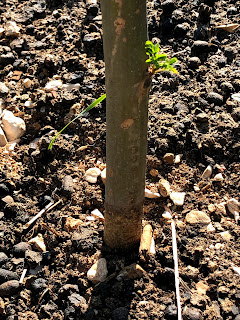29-30 April 2020
Into another day of bramble attack, but at least we now have a reasonably-sized clearing. The shaded area looks like it could be good as a mushroom cultivation site. Something we can investigate in the autumn.
Into another day of bramble attack, but at least we now have a reasonably-sized clearing. The shaded area looks like it could be good as a mushroom cultivation site. Something we can investigate in the autumn.
The black tank on the left was installed maybe six years ago, and has collected water, but has never been piped into a distribution system. We've always been too busy building the house to deal with this. But now the house is finished, we can organise these forgotten corners a little better. And keep them maintained!
I went to lift the re-purposed sieve-filter from the barrel, which had opportunistic brambles established in it, and found an incredible root system growing through the sieve into the water below. No wonder the brambles have been so vigorous!
Down at the pond - the first water lily bud reaches the surface.
Maybe we'll have a flower for May Day? But the bad news is that we seem to have lost two fish in two days. Cats and crows or magpies are top of the suspect list.
Back at the brambles, I thought it best to get rid of the monster pile of cuttings as soon as possible. Any piece of viable bramble can root and cause trouble, so I used some of the pond liner offcuts under the chipper ...
... and under the pile of chips. We hope that if we let these compost for a couple of years, they will rot down and can be used as a mulch without seeding brambles throughout the garden.
A selection of the brambles to be chipped. Thick gloves required.
Dave, meanwhile, has started strimming all round the land again. It's that time of year!
Excellent news from my son on Weds morning. My new granddaughter was born safely and well over night. Hurrah!
So we raised a glass of Dave's ginger beer to celebrate.

















































